
![]()
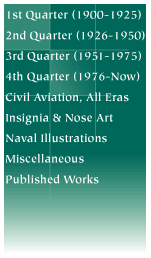
Nieuport Gallery
By Bob Pearson
Developed from the elegant little Nieuport 11 ' Bebe', the Nieuport 17 and its derivatives served the French Avaition Militaire from mid-1916 into 1918, and was used by all the Allied air services.
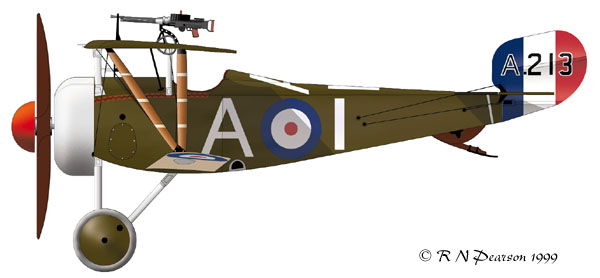
Nieuport 17 A213
Captain Albert Ball
No.60 Sqn RFC
September 1916
Flown by the first of the RFC's great aces, Albert Ball, A213 exhibits the finish carried by the first Nieuports to enter British service. Research by Les Rogers and Sqn/Ldr Joe Warne show that these aircaft were finished in French Olive Drab upper surfaces and Clear Doped Linen undersurfaces. The flight marking is speculative based on marking practices of No.60 Sqn at the time. For a more indepth study of this aircraft and its pilot I recommend the book VICTORIA CROSS: WW1 AIRMEN AND THEIR AIRCRAFT by Alex Revell (illustrated by myself) and published by Flying Machines Press.
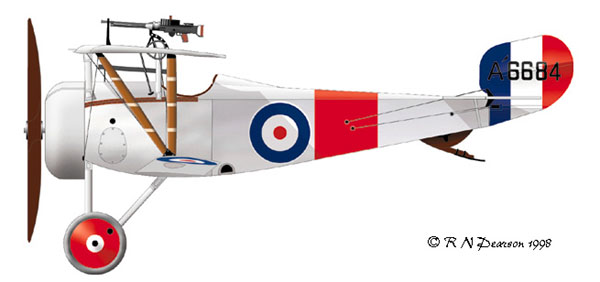
Nieuport 17 A6684
No.29 Sqn RFC
April/May 1917
The classic appearance of the Nieuport 17 was an overall aluminum/silver finish. And this Royal Flying Corps machine shows it well. Although coloured wheel covers were quite common in British units, bright fuselage markings were generally frowned upon, so it is surprising to find that No.29 Sqn was able to make use of a red band on their aircrafft during the Spring of 1917.
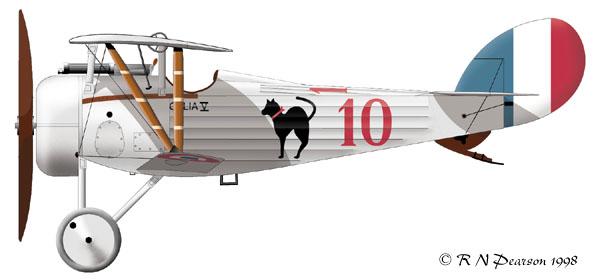
Nieuport 24
Corporal William Wellman
Escadrille N.87 'les Chats Noir/the Black Cats'
March 1918
After the Ni.17 (and the similar Ni.23), the next innovation was fairing in the fuselage to a circular section. this was characteristic of the remaining Nieuport designs up to the NIe.29. The Nie.24 also featured a redesigned tail assemnbly of elegant appearnce and a plywood covered fin and rudder.
Seen here is the aircraft of the American, Wiliam Wellman. Wellman is better known as the first recipient in 1927 of the new Academy Award fort Best Director for his movie 'Wings'.
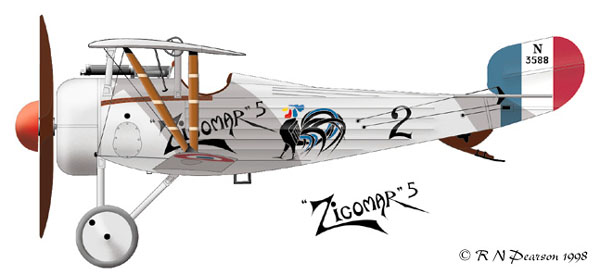
Nieuport 24bis N3588
Lt. Paul Tarascon
Escadrille N.62
Tarascon used the rooster and the nickname 'Zigomar' - a popular fictional character who was constantly getting into trouble - as his personal marking. The Rooster was later adopted by N.62, but changed to a more aggressive stance. Tarascon lost his right foot in a prewar flying accident, however, despite his handicap he was accepted for aviation duty and eventually scored 12 victories.
The Nieuport 24bis reverted to the tail surfaces of the Nieuport 17 for reasons given in Tom Cleaver's article.
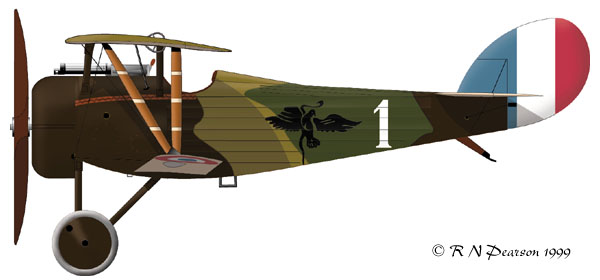
Nieuport 27
Lt Jacques Auguste Chaudon
Escadrille N.158
January 1918
The last of the sesquiplane Nieuports was the Nie.27. By this time the design had run its course and it was just the less-then- hoped-for performance of the SPAD VII and XIII that kept them in service. By this time the benefits of camouflage were becoming more known and most French aircraft were finished in five colour camouflage of light green, dark green, beige, chestnut brown and black on their uppersurfaces as seen on this Nie.27 of N.158. Interestingly they later re-equipped with the Morane Saulnier AI parasol fighter. . one of only two units to do so. . however these didn't last long and by the summer of 1918 Escadrille 158 was flying SPADs.